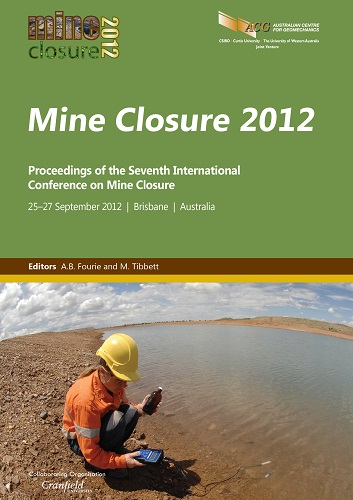Management and financing of post-closure liabilities

|
Authors: Bocking, KA; Fitzgerald, P |
DOI https://doi.org/10.36487/ACG_rep/1208_06_Bocking
Cite As:
Bocking, KA & Fitzgerald, P 2012, 'Management and financing of post-closure liabilities', in AB Fourie & M Tibbett (eds), Mine Closure 2012: Proceedings of the Seventh International Conference on Mine Closure, Australian Centre for Geomechanics, Perth, pp. 49-56, https://doi.org/10.36487/ACG_rep/1208_06_Bocking
Abstract:
At many mine sites, the implementation of planned closure measures will not result in the desired ‘walk-away’ scenario. After a mining company spends all their capital expenditures and completes their promised closure measures, they may still have ongoing liabilities and risks, which could vary from simple routine care and maintenance of the site to ongoing treatment of effluent to ‘risk costs’ associated with the potential for earthquakes or floods. Where such liabilities continue to exist after closure, it will be necessary to make definitive arrangements for the ongoing management of the mine site in the long term, if not perpetually. Such site management will carry costs, so it will also be necessary to have sustainable financing in place. It is clear that mining companies do not last forever; therefore the management arrangements and financing must be sustainably independent of the existence of the mining company. Many jurisdictions have provisions for closed mining properties to be ‘returned to the crown’. Where this occurs, the responsible government will also have to make similar arrangements for the long term management and financing of a portfolio of returned sites. This paper gives examples of post-closure liabilities and costs. It also discusses using risk modelling to estimate future costs and discusses alternative approaches for long term sustainable financing.
References:
Bocking, K.A., Kam, S.N., Welch, D.E. and Williams, D.A. (2009) Management of mine sites after closure, in Proceedings Fourth International Conference on Mine Closure (Mine Closure 2009), A.B. Fourie and M. Tibbett (eds), 9‒11 September 2009, Perth, Australia, Australian Centre for Geomechanics, Perth, pp. 245–252.
Bocking, K.A. (2010) Post-closure liabilities, Australian Centre for Geomechanics Newsletter, November 2010, pp. 20–23.
Butler, H. and Bentel, G. (2011) Mine relinquishment – processes and learnings, in Proceedings Sixth International Conference on Mine Closure (Mine Closure 2011), A.B. Fourie, M. Tibbett and A. Beersing (eds), 19‒21 September 2011, Lake Louise, Canada, Australian Centre for Geomechanics, Perth, Vol. 2, pp. 3–12.
Cowan, W.R., Mackassey, W.O. and Robertson, J.G.A. (2010) The Policy Framework in Canada for Mine Closure and Management of Long-Term Liabilities: A Guidance Document, Prepared for National Orphaned / Abandoned Mines Initiative, November, 2010.
Kirschener, L.A. and Grandy, E.B (2003) Mining and the vanishing surety bond market, Natural Resources and Environment, Vol. 17, No. 3, pp. 152–154.
Poulin, R. and Jacques, M. (2007) Mine reclamation bonding and environmental insurance, International Journal on Risk Assessment and Management, Vol. 7, No. 5, pp. 589–606.
© Copyright 2025, Australian Centre for Geomechanics (ACG), The University of Western Australia. All rights reserved.
View copyright/legal information
Please direct any queries or error reports to repository-acg@uwa.edu.au
View copyright/legal information
Please direct any queries or error reports to repository-acg@uwa.edu.au